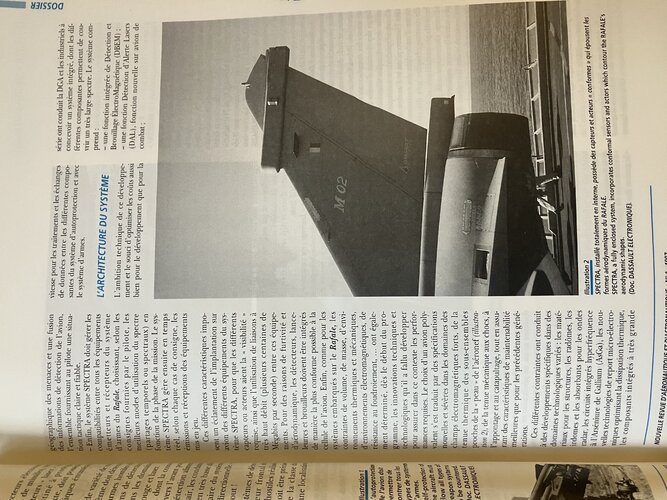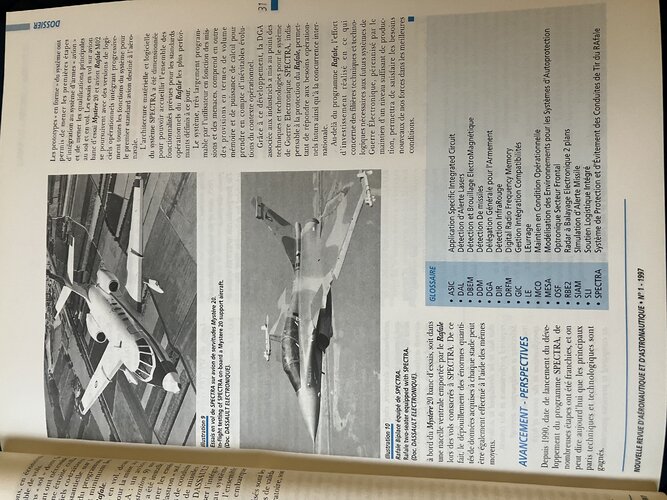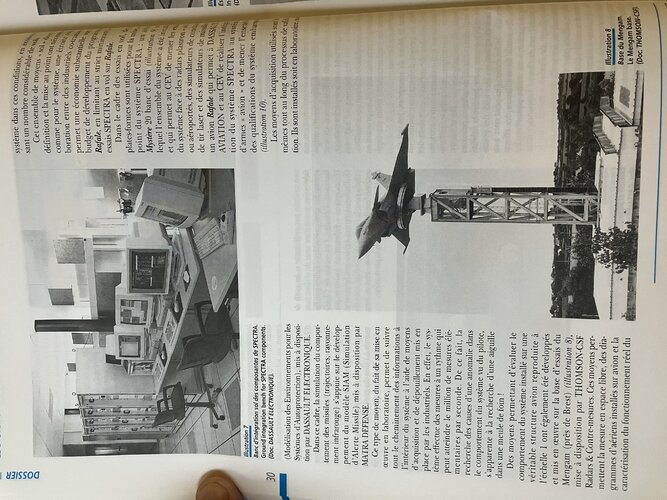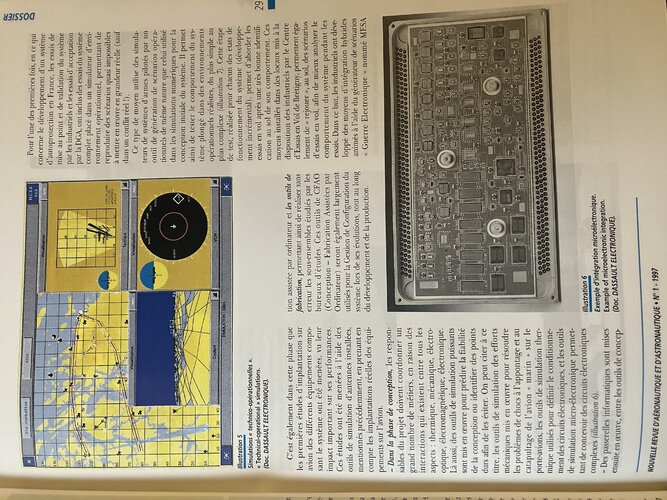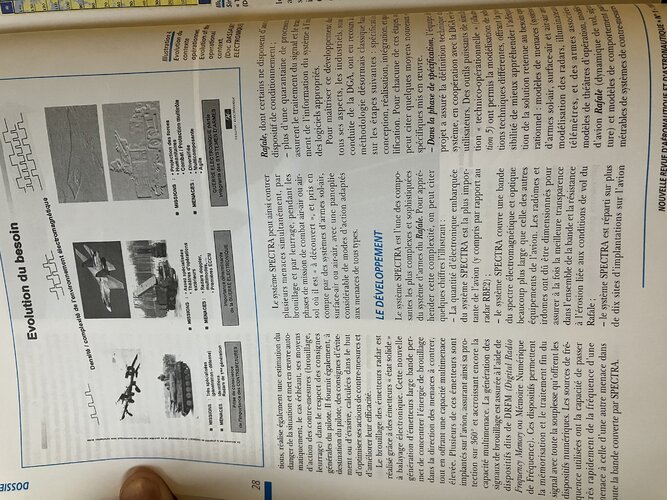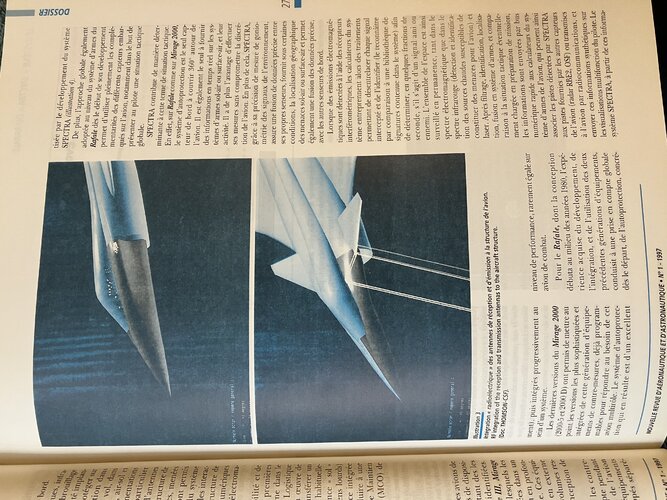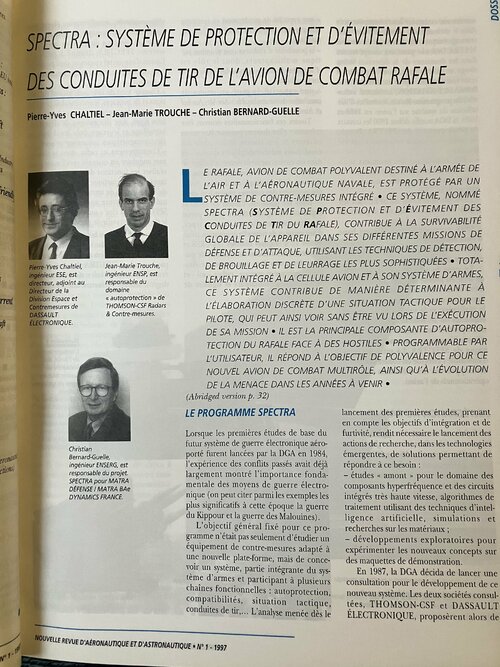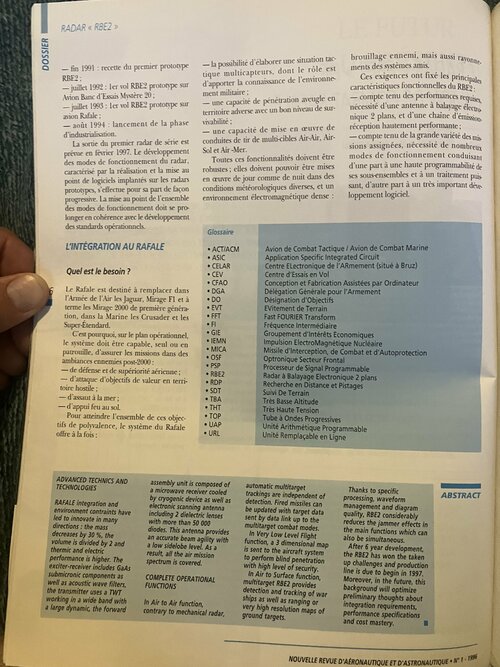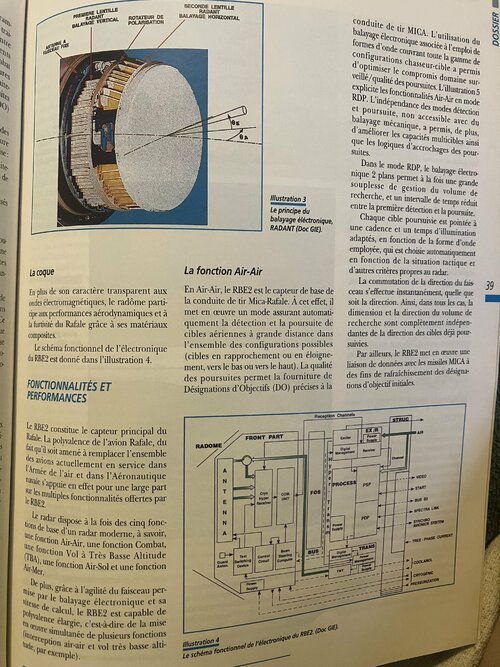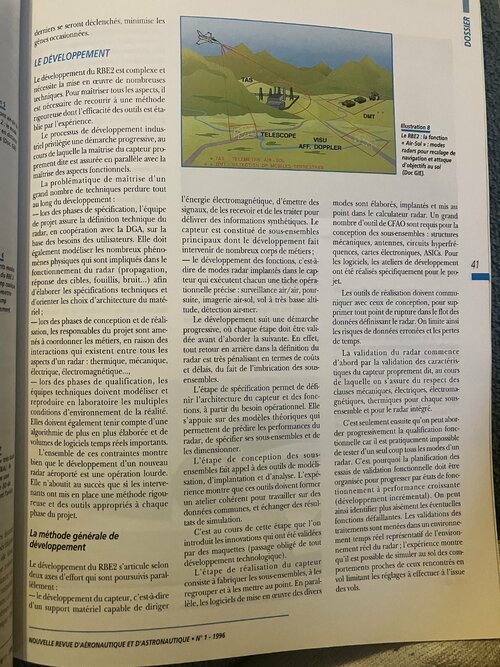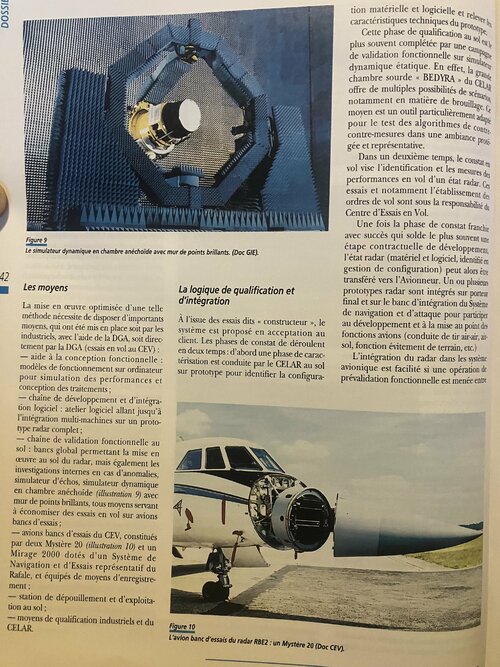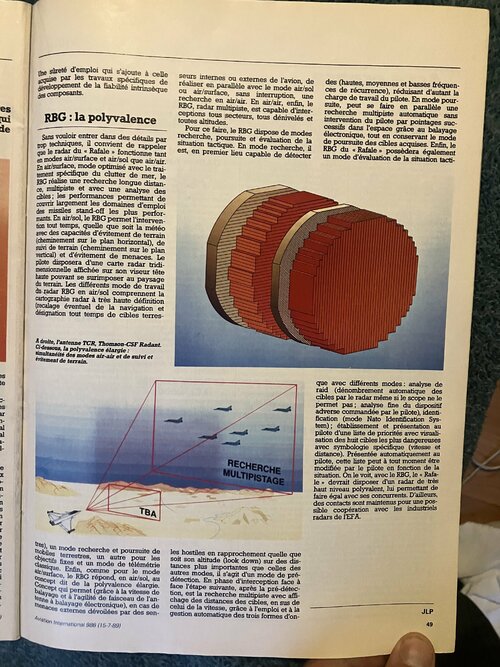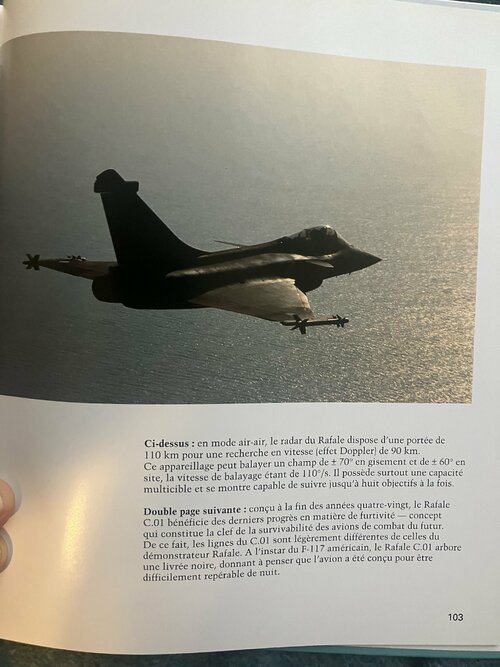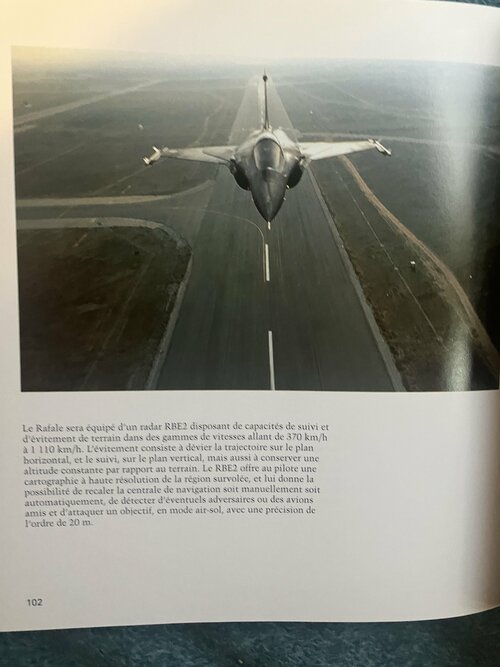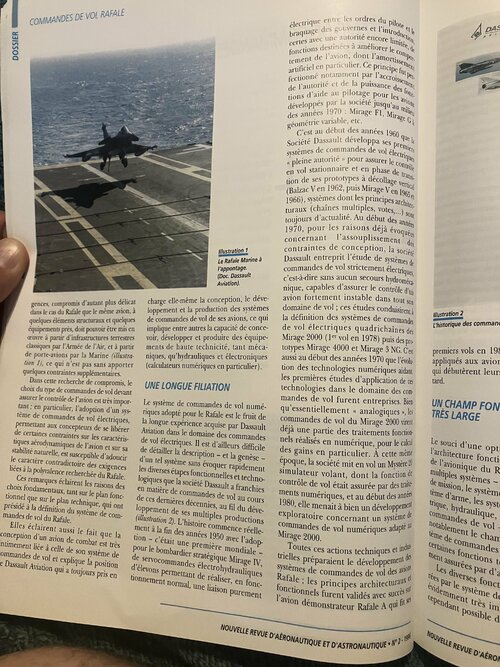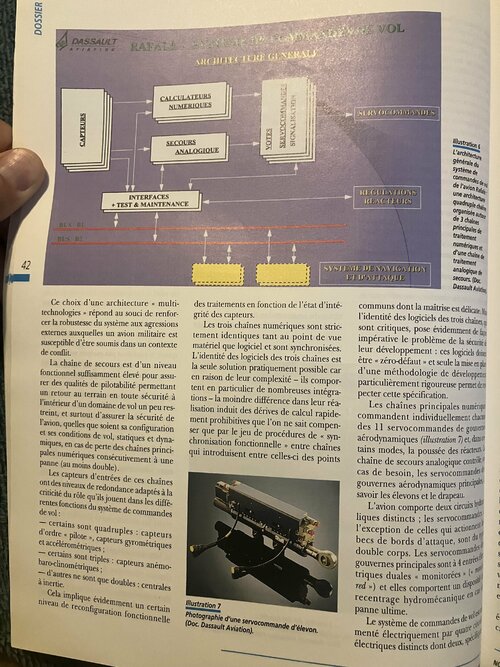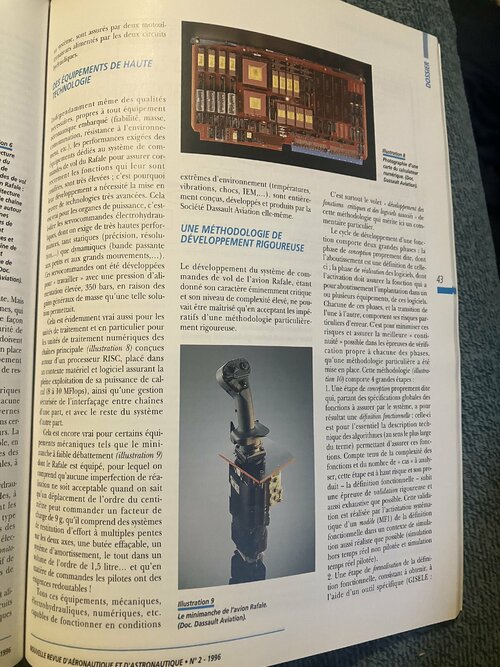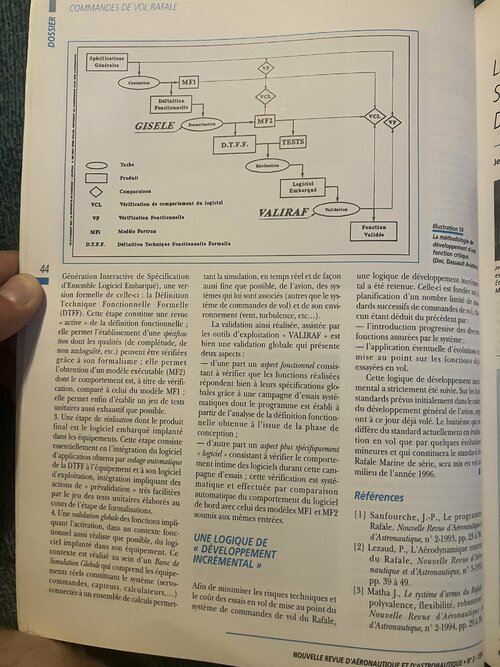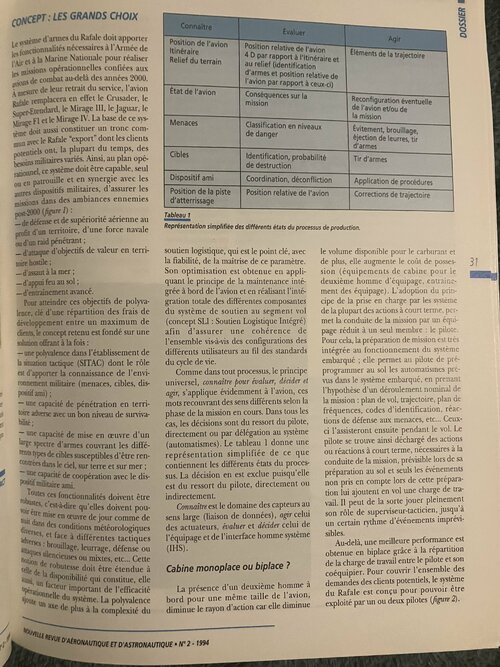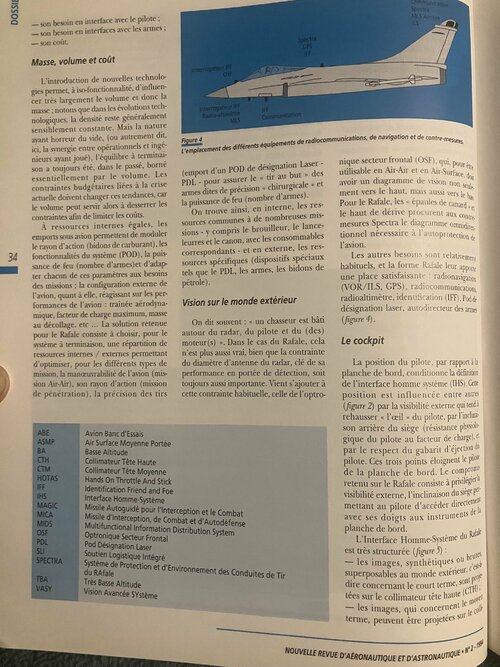NT CASE THE "RBE2" RADAR OF THE RAFALE COMBAT AIRPLANE Philippe RAMSTEIN and Max SCHUMPERLI THE RAFALE SHOULD ULTIMATELY REPLACE ALL THE AIRCRAFT CURRENTLY IN SERVICE IN THE AIR FORCE AND IN NAVAL AERONAUTICS, IT WAS NECESSARY TO PROVIDE IT WITH A RADAR COMBINING ALL THE FUNCTIONALITIES OF THE SPECIALIZED RADARS OF PREVIOUS GENERATION • THE RBE 2 - RADAR WITH ELECTRONIC SCANNING 2 PLANES - MEETS THIS AMBITIOUS OBJECTIVE OF VERSATILITY • Max SCHUMPERLI, ISEN Engineer, is Deputy Director of the Detection Division of DASSAULT ÉLECTRONIQUE. 35 Philippe RAMSTEIN, X-ENST engineer is director of the “Elancourt” radar programs at the THOMSON-CSF Radars & Contre-mesures subsidiary. THE RBE 2 PROGRAM signal and information, materials, subassemblies; The implementation of the RBE2 program was the result of a long preparation since already at the beginning of the 80s, the need to have a common radar for all missions was taking shape. This need has led to a search in emerging technologies for solutions to meet this need: electronic scanning antenna, very high-speed integrated circuits, composite materials, etc., which has led to the launch of a series of actions with the help from the DGA: — exploratory developments to validate in flight, on models, the new concepts. The development of the RBE2 was entrusted at the end of 1988 to the GIE Radar ACT/ACM RAFALE, bringing together the companies Thomson-CSF (for 2/3) and DASSAULT ELECTRONIQUE (for 1/3), which was notified to the end of 1989 the development work on the RBE2. Since then, many important milestones have been reached: mid 1989: start of development work - upstream studies in the field of components, processing algorithms prototype development; RADAR «RBE2> enemy jamming, but also radiation from friendly systems. - the possibility of developing a multi-sensor tactical situation, the role of which is to provide knowledge of the military environment; - end of 1991: acceptance of the first prototype These requirements set the main functional characteristics of RBF2: — taking into account the performance required, the need for a 2-plane electronic scanning antenna and a high-performance transmission-reception chain; - given the wide variety of missions assigned, the need for numerous operating modes leading on the one hand to high programmability of its sub-assemblies and to powerful processing, on the other hand to a very significant development software development. CASE RBE2: -July 1992: 1st prototype RBE2 flight on Airplane Mystery 20 Test Bench; -July 1993: 1st prototype RBE2 flight on a Rafale aircraft; - August 1994: launch of the industrialization phase. - an ability to blindly penetrate enemy territory with a good level of survivability; - an ability to implement Air-Air, Air-Ground and Air-Sea multi-target fire control. All of these features should be The release of the first series radar is scheduled for February 1997. The development of radar operating modes, characterized by the creation and development of software installed on the prototype radars, is being carried out gradually. The fine-tuning of all operating modes must continue in line with the development of operational standards. robust; they must be able to be implemented day and night in various meteorological conditions, and a dense electromagnetic environment: Glossary RAFALE INTEGRATION Tactical Fighter / Marine Fighter Application Specific Integrated Circuit •ACT/ACM • ASIC Armament Electronics Center (located in Bruz) Flight Test Center • CELAR What is the need? • BODY • CAD/CAM Computer Aided Design and Manufacturing The Rafale is intended to replace the Jaguars, Mirage F1s and eventually the first-generation Mirage 2000s in the Air Force, and the Crusaders and Super-Etendards in the Navy. • DGA General Delegation for Armaments • DO Designation of Objectives • POSSIBLY Terrain Avoidance • FFT Fast FOURIER Transform • BE Intermediate Frequency This is why, operationally, the system must be capable, alone or on patrol, of ensuring missions in post-2000 enemy environments: - defense and air superiority; GIE •IEMN Economic Interest Grouping Nuclear Electromagnetic Pulse Front Sector Optronic Interception, Combat and Self-Protection Missile • MICA • OSF Programmable Signal Processor • PSP •RBE2 2-Plane Electronic Scanning Radar Range Finder and Tracking - attacking valuable land targets; • RDP hostile tory • SDT Very Low Altitude Terrain Following -storming at sea; • TBA - fire support on the ground. • THT Very High Voltage To achieve all of these versatility objectives, the Rafale system offers both: • TOP Traveling Wave Tube • STEAM Programmable Arithmetic Unit Line Replaceable Unit • URL ADVANCED TECHNICS AND TECHNOLOGIES assembly unit is composed of a microwave receiver cooled by cryogenic device as well as electronic scanning antenna including 2 dielectric lenses with more than 50 000 diodes. This antenna provides an accurate beam agility with a low sidelobe level. As a result, all the air mission spectrum is covered. automatic multitarget Thanks to specific trackings are independent of detection. Fired missiles can be updated with target data sent by data link up to the multitarget combat modes. ABSTRACT processing, waveform management and diagram quality, RBE2 considerably reduces the jammer effects in the main functions which can also be simultaneous. RAFALE integration and environment contraints have led to innovate in many directions: the mass In Very Low Level Flight function, a 3 dimensional map is sent to the aircraft system to perform blind penetration with high level of security. decreases by 30%, the volume is divided by 2 and thermic and electric performance is higher. The exciter-receiver includes GaAs submicronic components as well as acoustic wave filters, the transmitter uses a TWT working in a wide band with a large dynamic, the forward After 6 year development, the RBE2 has won the taken up challenges and production line is due to begin in 1997. Moreover, in the future, this background will optimize preliminary thoughts about integration requirements, performance specifications and cost mastery. In Air to Surface function, multitarget RBE2 provides detection and tracking of war ships as well as ranging or very high resolution maps of ground targets. COMPLETE OPERATIONAL FUNCTIONS In Air to Air function, contrary to mechanical radar, NEW JOURNAL OF AERONAUTICS AND ASTRONAUTICS N° 1-1996 Integration requirements The variety of situations to be dealt with as well as the foreseeable evolution of threats during the life of the aircraft led the GIE to design a radar capable of making the best use of the maximum possible resources. The material is therefore as universal as possible and offers significant possibilities: The development of an operational radar requires the production of equipment that must satisfy not only the required performance, but also the weapon integration requirements. and environment on aircraft - dialogue with the Rafale weapons system. 4. The mini-structure supports these three subassemblies, the assembly constituting the CASE rear part of the radar. 5. The front assembly consists of the electronically scanned antenna and its control circuits as well as microwave reception. that ways of The choice of a multi-purpose aircraft, equipped with a single radar to ensure all the missions of the Naval and Air Aeronautical Forces has resulted in new and severe specifications that the RBE2 must fully satisfy. They relate to a wide variety of characteristics, from resistance to IEMN (Nuclear Electro-Magnetic Pulse) and strong fields, to the “shock” environment of the landing/catapulting and to the maintenance. -of Doppler waveform or not; 6. The shell is made up of a ferrule allowing the front part of the radar to be fixed to the aircraft, and a radome transparent to electromagnetic waves. pulse duration; illumination time. The RBE2 consists of six removable sub-assemblies (illustration 2) called "< URL" - Replaceable Units The integration of pilot functions and Online: 1. The pilot/receiver unites in the same box: receiver Frequency synthesis uses gallium arsenide technologies and sub-micron etched surface acoustic wave filters. Responding to new requirements for spectral purity and frequency agility, these microwave circuits ensure the transposition necessary for transmission in a wide frequency range. These efforts have made it possible to integrate the pilot and receiver functions in the same box, and thus save a factor of 2 in mass and volume compared to the previous generation. However, three characteristics determined from the start of the program the technological innovations that had to be studied and developed for the RBE2: mass, volume, thermal and electrical environment. the functions for generating the microwave to be transmitted; the functions of IF reception and analog/digital conversion of the signals received. 37 2. The transmitter amplifies the microwave signal from the pilot/receiver. In comparison with previous radars, the weight reduction of the RBE2 is more than 30%. The RBE2 also includes support and connection devices for the OSF box (Optronics Frontal Sector) which is installed between the front and rear parts of the radar, which gives the OSF the best possible detection coverage. 3. The processing performs the following main functions: - signal processing; - information processing; The effort imposed on the volume of the RBE2, compared to the Mirage 2000 radars, is a reduction by a factor of 2 for the Pilot/Receiver-Transmitter-Processing assemblies: this objective has been achieved. JRBE For a level of heat dissipation of the same class as the previous radars, the constraints at component level are much more severe due to the drastic increase in the power density to be evacuated. This specification turned out to be the most restrictive. Compliance with it has required the study and development of very advanced technologies and integration processes, to solve all the problems, electrical, thermal and mechanical. Thus, all of the requirements, both functional and integration, have fixed the characteristics of the RBE2 hardware architecture, the developments to be carried out of the functions adapted to each situation, and thereby the methods and means to implement work for the design, production and development (illustration 1). To Illustration 1 The RBE2 on RAFALE at Istres (photo Dassault Aviation) NEW JOURNAL OF AERONAUTICS AND ASTRONAUTICS N° 1-1996 RADAR «RBE2>> PLOT RECEIVER TREATMENT CASE PART Given the diversity of radar modes, a versatile architecture was chosen, the flexibility of which is characterized -by total processing programmability (no hard-wired processing outside of TFF); - by the use of unmarked processors - usable in all modes; - by using the floating format. STRUCTURE Furthermore, in order to give great flexibility to the programming of the modes, a limitation of the number of types of cards as well as the use of standard processors have been sought as a priority. RECEIVER DRIVE TREATMENT The 38 AND This processing has a computing power of approximately 1.4 billion operations per second, in a volume of 38 liters. This level of integration could only be obtained by using numerous ASICs (class 100,000 gates in sub-micronic technology), as well as by resorting to hybrid microelectronic technologies. of the J d Illustration 2 The subsets of F RBE2 radar, mounted on the Rafale (excluding Sector Optronics P The front set Frontal). (Doc GIE). The two-plane electronically scanned antenna uses the RADANT process. The union of two lenses of approximately 25,000 diodes each allows the beam to be depointed in the horizontal and green planes. This principle makes it possible to instantly reach any direction with great precision in a cone of 60° half-angle at the vertex (illustration L The transmitter R have been implemented: abandonment of oil to ensure EHV insulation in favor of pressurization by an inert gas, interchangeability of the three TOP sources with a minimum of adjustment adjustments, fiber optic links . The transmitter, with its spectral purity and power characteristics, makes an essential contribution to maintaining the performance of the RBE2. Compared to the previous generation, it delivers in a much wider microwave band, a much higher average power. d S P The treatment This antenna offers very high beam ag lity allowing ope mized space management: it has a very low level of secondary and diffuse lobes, excellent detection performance at very low altitude and increased efficiency in the presence of jamming. The Processing Unit comprises two essential processing units: - the PSP - Programmable Signal Processor which handles all the processing of the operating mode signal. It allows, among other things, the detection and measurement of air and sea targets (Air-Air, Combat and Air-Sea functions) as well as ground echoes in front of the aircraft (TBA and Air-Ground functions). For the TOP with coupled cavities, the development of which was carried out by three manufacturers, these performances, with satisfactory microwave efficiency, are at the border of what is currently available in series. in A Finally, to respond to requests for alleviation of maintenance constraints, new technical solutions Another element of progress, the cooling by cryogenic devices of the microwave receiver makes it possible to reduce the noise factor of the reception chain, thus increasing the range of the radar. NEW JOURNAL OF AERONAUTICS AND ASTRONAUTICS N°1-1 FIRST VERTICAL SCAN RADANT LENS POLARIZATION ROTATOR ram- MICA fire control. The use of electronic scanning associated with the use of waveforms covering the whole range of fighter-target configurations has made it possible to optimize the compromise monitored domain/tracking quality. Illustration 5 explains the Air-Air functionalities in RDP mode. The independence of the detection and tracking modes, not accessible with mechanical scanning, has also made it possible to improve the multi-target capacities as well as the tracking lock-up logics. male between FIXED BEAM ANTENNA CASE ents bal res do- ites 00) BE of the NOT ure with: In RDP mode, electronic 2-plane scanning allows both great flexibility in managing the search volume, and a reduced time interval between the first detection and tracking. A little of Illustration 3 you are The principle of electronic scanning, RADANT (Doc GIE). Each tracked target is pointed at an appropriate rate and illumination time, depending on the waveform used, which is chosen automatically depending on the tactical situation and other criteria specific to the radar. Of- it is is The Air-Air function Shell an- Beam direction switching is instantaneous, regardless of direction. Thus, in all cases, the size and direction of the search volume are completely independent of the direction of the targets already being tracked. 39 In Air-Air, the RBE2 is the basic sensor of the Mica-Rafale fire control. To this end, it implements a mode that automatically detects and tracks aerial targets at long distances in all possible configurations (targets approaching or moving away, downwards or upwards). . The quality of the pursuits allows the provision of precise Target Designations (DO) to the In addition to its transparent nature to electromagnetic waves, the radome contributes to the aerodynamic performance and stealth of the Rafale thanks to its composite materials. of ns This as well with The block diagram of the RBE2 electronics is given in Figure 4. In addition, the RBE2 implements a data link with the MICA missiles for the purpose of refreshing the initial target designations. 0 FEATURES AND PERFORMANCE Reception Channels The RBE2 is the Rafale's main sensor. The versatility of the Rafale aircraft, from the fact that it is required to replace all the aircraft currently in service in the Air Force and in Naval Aviation, is in fact based to a large extent on the multiple functionalities offered by the RBE2. STRUC EX /R AIR Power Supply FRONT PART Exciter WE FOUND S Digital Receiver Management Channel and ANTENNA VIDEO It is PROCESS PSP START FOS Cryo Hyper Receiver AS UNITED BUS B2 The radar has at the same time the five basic functions of a modern radar, namely, an Air-Air function, a Combat function, a Flight at Very Low Altitude (TBA) function, an Air-Ground function and a Air-Sea function. r SPECTRA LINK PDP n SYNCHRO AVIONICS SYSTEM S Power Supply m -TREE-PHASE CURRENT TRANS Power BUS Beam Steering Computer Digital Management Test Switching Device Control Circuit Management COOL Guard Ants COOLANOL Supply In addition, thanks to the agility of the beam enabled by electronic scanning and its calculation speed, the RBE2 is capable of extended versatility, i.e. of placing (air-to-air interception and very low flight simultaneous work of several study functions, for example). TWT CRYOGENIC PRESSURIZATION Power Supply Illustration 4 The block diagram of the RBE2 electronics. (GIE document). specific raid analysis mode allows enemy targets to be counted in order to improve the level of information transmitted to the system and to the pilot. DOSS RESEARCH THE PROSECUTION 17 PROSECUTION IN THE VOLUME IA RESEARCH The Combat Function PROSECUTION LIAISONS MISSILE AIRPLANE PROSECUTION The RBE2 provides fast automatic acquisition and tracking of four highly scalable targets. Several acquisition patterns are available, depending on the location of the targets. The parameters of the targets being tracked are transmitted to the system for the implementation of the MAGIC 2, MICA-IR and Canon fire controls (illustration 6). MULTI-CHASES Illustration 5 The air-to-air functions of the RBE 2 radar: the distance search and tracking mode (Doc. GIE RDP EVALUATION PRIORITY LIST RAID ANALYSIS RADAR DOMAIN SMALL CONICAL DAMP PLAN DE SYMMETRIE The Very Low Altitude Function (TBA) GRAND CONICAL FIELD In this function, the RBE2 produces a three-dimensional map of the terrain in front of the aircraft (illustration 7). This map is used by the system as part of the very low altitude penetration function of the Rafale, whether in automatic terrain following mode (SDT-guidance in vertical plane) or in terrain avoidance mode (EVT -guidance in horizontal plane). Illustration 6 40 LARGE DEPOSIT The various modes of combat of the RBE 2 small conical field plane of symmetry - large field - large bearing (Doc GIE). The identification of obstacles with strong vertical development (such as pylons), the elimination of atmospheric echoes and numerous failure tests contribute to obtaining a high level of safety and performance. The Air-Ground Function The RBE2 implements all the modes necessary for the system requirements in Air-Ground missions (illustration 8): Air-Ground Telemetry (TAS) and refined ground mapping allowing Rafale navigation readjustments and the supply of target designations for the firing of Air-Ground weapons with maximum precision ; Illustration 7 The “very low altitude” (TBA) function: the radar produces a 3D map of the terrain in front of the aircraft (GIE Doc). High resolution ground mapping allowing, in addition to the functionalities of the refined ground mapping, to contribute to the precise identification of the objectives. anti-jamming nally, to the use of multiple waveforms and thanks to the specific processing implemented in each mode of operation, the RBE2 has foolproof electromagnetic jamming, in all its modes, the implementation and a robust in an environment of capabilities for identifying adversary countermeasures systems then, when c these and delays. The Air-Sea Function Countermeasures systems provide remote detection of transmitters and attempt, through combinations of jamming and decoys, to render firing lines ineffective. The RBE2 implements a mode ensuring the detection and tracking of ships at long range, thus allowing the Rafale to be able to fire anti-ship missiles from a safe distance. Thanks to the flexibility of electronic scanning, the quality of the ray diagram NEW JOURNAL OF AERONAUTICS AND ASTRONAUTICS N°1-1996 will have been triggered, minimizes the inconvenience caused. CASE DEVELOPMENT The development of RBE2 is complex and requires the implementation of many techniques. To control all the aspects, it is necessary to resort to a rigorous method whose effectiveness of the tools is established. THAT ons air-r DMT 2: the mod blessed by experience. The process of industrial development Illustration 8 in distant TELESCOPE The RBE2: the “Air-Ground” function: modes SEE AFF. DOPPLER (Doc G a progressive approach, at the triel favors the course of which the control of the sensor itself is ensured in parallel with the s functional aspects. mastery of radars for navigation readjustment and ground target attack (GIE Doc). TAS TELEMETRIE AIR-SOL DMT DETECTION DE MOBILES TERRESTRES The problem of mastering a large number of techniques persists throughout development: - during the specification phases, the team electromagnetic energy, to emit signals, to receive them and to process them to deliver synthetic information. The sensor is made up of main sub-assemblies whose development involves numerous trades; - the development of functions, i.e. modes are developed, implemented and developed in the radar computer. A large number of CAD/CAM tools are required for the design of sub-assemblies: mechanical structures, antennas, microwave circuits, electronic boards, ASICs. For the software, the development workshops were carried out specifically for the project. responsible for the technical definition of the radar, in cooperation with the DGA, based on user needs. It must also model the many physical phenomena that are involved in the operation of the radar (propagation, target response, clutter, noise, etc.) in order to develop the technical specifications and guide the choices of architecture of the mate. - riel; 6 41 nts mode say radar modes implanted in the sensor, each of which performs a specific operational task: air/air surveillance, tracking, air-ground imagery, flight at very low altitude, air-sea detection. you RBE 2 conical mp The production tools must communicate with the design tools, to eliminate any break point in the flow of data defining the radar. This limits the risk of erroneous data and loss of time. metrics mp ement The development follows a progressive approach, where each stage must be validated before tackling the next one. Indeed, any backtracking in the definition of the radar is very penalizing in terms of costs and delays, due to the overlapping of the sub-assemblies. - during the design and construction phases, the project managers have to coordinate the trades, because of the interactions that exist between all the aspects of a radar: thermal, mechanical, electrical, electromagnetic, etc. , Validation of the radar begins first with the validation of the characteristics of the sensor itself, during which we ensure compliance with the mechanical, electrical, electromagnetic and thermal clauses for each sub-assembly and for the radar. integrated. - during the qualification phases, the technical teams must model and reproduce in the laboratory the multiple environmental conditions of reality. They must also take into account an increasingly sophisticated algorithm and large volumes of real-time software. The specification stage enables the architecture of the sensor and the functions to be defined, based on the operational need. It is based on theoretical models which make it possible to predict the performance of the radar, to specify its sub-assemblies and to dimension them. It is only then that we can gradually approach the functional qualification because it is practically impossible to test all the modes of a radar at once. This is why the planning of the functional validation tests must be organized to progress by operating states with increasing performance (incremental development). This makes it easier to identify any faulty functions. Processing validations are carried out in a real-time environment representative of the real radar environment; experience shows that it is possible to simulate on the ground behavior similar to that encountered in flight, limiting the adjustments to be made at the end of the flight. All of these constraints show that the development of a new airborne radar is a heavy operation. It only leads to success if those involved have implemented a rigorous method and appropriate tools at each phase of the project. very b The sub-assembly design stage uses modeling, implementation and analysis tools. Experience shows that these tools must form a coherent workshop for working on common data, and exchanging results. CHARM it's a 30 d simulation states. It is during this stage that we The general method of development introduces innovations that have been validated by models (an obligatory step for any technological development). The development of the RBE2 is based on two axes of effort which are pursued in parallel: - the development of the sensor, i.e. The step of producing the sensor consists of manufacturing the sub-assemblies, grouping them together and developing them. At the same time, the software for implementing the various of one hardware support capable of directing NEW JOURNAL OF AERONAUTICS AND ASTRONAUTICS N° 1-1996 FILE Secondly, in-flight observation aims to identify and measure the in-flight performance of a radar condition. This testing and in particular the establishment of flight orders are the responsibility of the Flight Test Center. Once the observation phase has been successfully completed, which most often completes a contractual development stage, the radar status (hardware and software, identified in configuration management) can then be transferred to the Aircraft Manufacturer. One or more radar prototypes are integrated on the final carrier and on the navigation and attack system integration bench to participate in the development and fine-tuning of aircraft functions (air-to-air, air-to-ground fire control, terrain avoidance function, etc.) Figure 9 The dynamic simulator in an anechoic chamber with wall of shining points. (GIE document). 42 The means The logic of qualification and integration The optimized implementation of such a method requires significant resources, which have been put in place either by manufacturers, with the help of the DGA, or directly by the DGA (flight tests at the CEV ): At the end of the so-called "manufacturer" tests, the system is offered for acceptance to the customer. The observation phases take place in two stages: first, a characterization phase is conducted by CELAR on the ground on a prototype to identify the configuration The integration of the radar into the avionics system is facilitated if a functional pre-validation operation is carried out between functional design assistance: computer operating models for performance simulation and treatment design; software development and integration chain: software workshop going as far as multi-machine integration on a complete radar prototype; functional validation chain on the ground: global benches allowing the implementation of the radar on the ground, but also internal investigations in the event of anomalies, echo simulator, dynamic simulator in an anechoic chamber (illustration 9) with wall of bright points, all means used to save flight tests on aircraft test benches; - CEV test bench aircraft, consisting of two Mystère 20 (illustration 10) and a Mirage 2000 equipped with a Navigation and Test System representative of the Rafale, and equipped with recording means; ground processing and processing station; - industrial and CELAR qualification means. Figure 10 The RBE2 radar test bench aircraft: a Mystery 20 (CEV Doc). - retains significant development potential. - future operational needs and international competition, requires a permanent investment effort in terms of development tools and in coherence with the long capitalized experience. the Aircraft Manufacturer and the Bodybuilder: using a so-called functional pre-validation bench, the Bodybuilder validates with the Bodybuilder the dialogue and the System commands between the radar and the aircraft, the command sequences being provided by the Aircraft Manufacturer. Indeed, the hardware and software architecture of the RBE2 assembly has been sized to be able to accommodate all the functionalities planned for the three Rafale darts defined to date. It also includes provisions in terms of memory and computing capacity for new modes that the inevitable evolution of the operational context will make necessary. These efforts will enable better control of development costs and a reduction in production costs. WHERE ARE WE ? OUTLOOK References The experience acquired on the development of the RBE2 has clearly shown that the overall cost constraint - development, - industrialization, series - must be a basic factor taken into account as far upstream as possible. the [1] ROUSSEAU G. (Senior Weapons Engineer). RBE2: The Rafale radar, After six years of development work, the technical bets of the RBE2 have been won: the current industrialization phase will lead to the delivery of production radars from 1997. L'ARMEMENT n° 47-Mai-June 1995. [2] GILON B., SCHUMPERLI M. A current example: The RBE2 radar of the Rafale, Science and Defense 1996. This overall cost is directly linked to the initial requirement specifications that [3] PLANTIER B., CHABOD L. Control either in terms of functionalities/performance of the development of airborne radars: requirements or in terms of integration constraints with the carrier aircraft (volume, mass, thermal, etc.), as well as the maturity of the technologies used. Thanks to the major principles adopted, high-tech modular hardware, variety of operating modes, rigorous design and development methods, the RBE2: methods and tools, Science and Defense 1996. [4] MATHA J. The Rafale weapon system: versatility, flexibility, robustness. New Review of Aeronautics and Astronautics n° 2-1994, pp. 29 to 38. - meets Rafale integration requirements; 43 - allows for each operational situation, to have the best adapted solutions; Finally, it should be remembered that maintaining airborne radar development capabilities to meet the



























